This post may contain affiliate links. If you use these links to buy something we may earn a commission. Thanks.
Various mushroom strains survive the freezing temperatures of cold climate winters, and the snow coverage actually helps keep logs and mushroom beds moist!
So it won’t be long before you’re picking fresh mushrooms, looking back, and thinking about how easy they were to grow.
If you’ve been wondering which mushrooms you can grow and how to grow mushrooms outside; I’ve included the growing methods each type prefers.
The easiest mushrooms to grow are wine caps, turkey tails, oysters, elm oysters, and shiitakes. From there, the difficulty increases.
Here, you can find out what it costs to grow mushrooms whether decide to grow them indoors or outdoors.
These mushrooms are ranked from top to bottom. As you scroll, the first mushroom is the easiest to grow, and the bottom is the most difficult.
1. King Stropharia wine caps (in mixed medium beds)
Wine caps are the easiest to grow. They prefer general woody debris and chips rather than a specific log or wood type.
The strategy for a mushroom bed that produces quick but long-term results relies on how you layer it.
You’ll need wine cap mycelium from a sawdust spawn kit and at least 3 or more types of growing medium. The best mediums are fresh straw, sawdust, leaves, and woodchips.
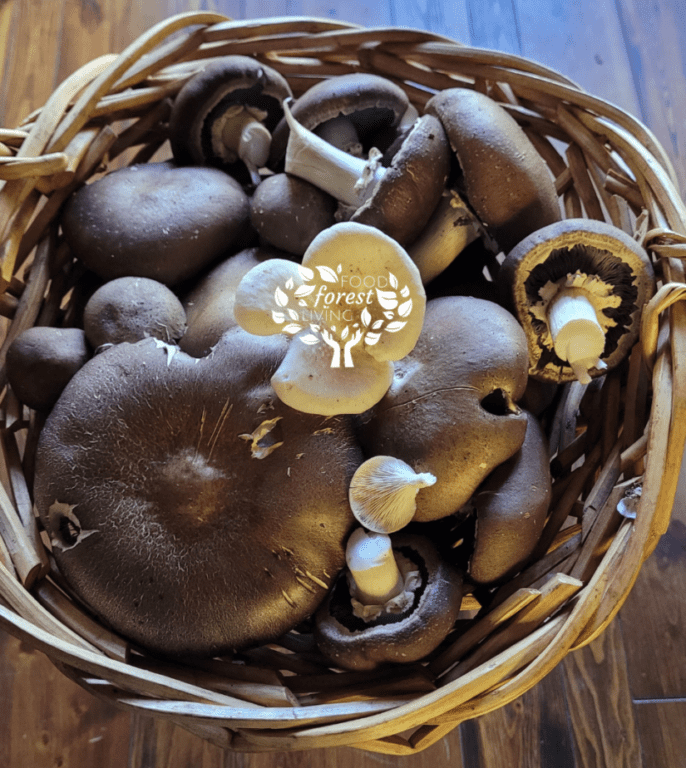
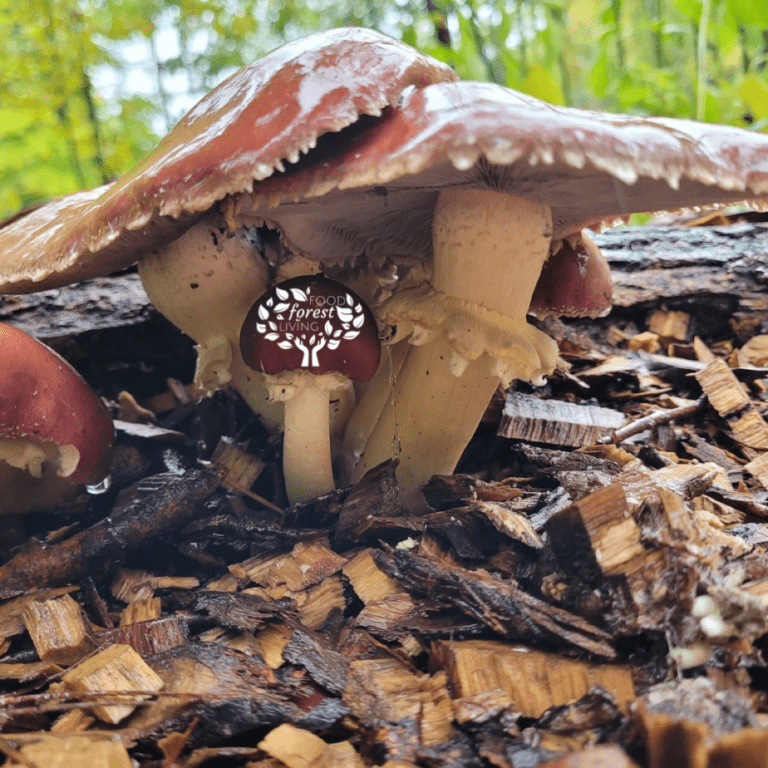
For layering; mycelium is the pasta, straw is the sauce, and wood chips are the cheese.
Start with moist ground and a well-watered bed of straw. Sprinkle in the first even layer of mycelium, more straw, then sawdust. Do another even layer of mycelium, and add a bit more straw, and sawdust. Continue this layering as many times as you have material for. Finally, give it a good watering but don’t soak it.
Quick colonization occurs from fine materials like sawdust, straw, and leaves. Woodchips are bigger chunks and take longer to colonize. The mycelium consumes fine materials first and will still have chips to eat while waiting for replenishment.
Each year, add fresh straw and sawdust on top of your mushroom beds to maintain production.
2. Oyster mushrooms (3 types and 3 ways)
Oyster mushrooms grow prolifically in forests, and we forage them a lot. We also cultivate more because there is never enough to satiate our appetites! They have a meaty seafood texture, but not a seafood taste.
Oyster mushrooms are easy and beginner-friendly to grow.
Pearl oysters, Italian, and blue oysters mushrooms are the easiest to grow on logs with plug spawn, but you can grow any type of oyster with relative ease.
Fruiting mushroom kits are one way to grow oysters, but you don’t get many because their food source is so small. To further cultivate them; we’ve taken spent medium from an oyster mushroom fruiting kit, smooshed it into the cracks of a large log, and successfully grew fresh mushrooms months later.
So if you aren’t ready to hammer plug spawn into fresh logs, do a taste test with some kits.
QUALITYSPAWN can be used at checkout for a discount on all items at North Spore.
North Spore is one of two places where we exclusively buy spawns because quality has a big impact on your degree of success with mushrooms. The other option is Grow Mushrooms Canada for my fellow Canadians! We have had great personal success with both places’ products.

This article was originally published on foodforestliving.com. If it is now published on any other site, it was done without permission from the copyright owner.
For logs; North Spore experts have tested numerous types of logs and recommend growing oysters on aspen, cottonwood, tuliptree, and willows. Second-choice wood includes; alder, beech, birch, box elder, elm, maple, and sycamore. Most hardwood or soft hardwood will have good success rates. They don’t recommend ash or oak wood for growing oyster mushrooms.
Oysters can also grow in straw beds. Simply sheet mulch an area to reduce competition, lay out some straw, sprinkle in the spawn, and layer the two items a few more times. When done, top it with straw, water it well, and cover it to keep it moist until there are signs of fruiting.
Related: How does a mushroom log work?
3. Shiitake (on 6 wood types)
Like oyster mushrooms, shiitake mushrooms are satisfyingly meaty! We find them to be a thicker and less sea-foodie type of “meat.” Cooked with homegrown garlic, salt, and pepper they are AMAZING tasting. Hands down the best mushroom I’ve ever had.
Shiitake mushrooms are easy and beginner-friendly to grow.
The taste and texture combined produce an “I can’t even” moment like no other on every bite. You literally forget between bites how good it is, and you’re surprised every time.

For growing outdoors, shiitake mushrooms are very productive on most hardwood logs. (Hardwood doesn’t necessarily mean “hardest” wood . . . many mushrooms do well on soft hardwoods! This article will tell you all about the best mushroom log options and why) They grow best on oak, then maple, alder, beech, birch, and poplar.
To make mushroom logs of any kind, you’ll need mushroom plugs and tools to inoculate fresh-cut logs at the right time of year.
4. Elm oyster (on straw or logs)
Elm oysters are tasty and easy to grow like regular oyster mushrooms.
They grow best on elm or beech logs. Like oyster mushrooms, they can also grow in a bed of straw outdoors.
It’s easiest to use elm oyster grain spawn to make mushroom beds, otherwise, you can get a liquid culture syringe to inoculate a fresh bag of plugs for making elm oyster logs.
5. Turkey tail (on various wood forms)
Turkey tail grows about everywhere in the world. They are as easy to grow as they are to forage. But if you’d rather not leave your backyard to enjoy a fresh brew of turkey tail tea; growing them is well worth it. They do have nonpoisonous look-alikes, so growing them will leave you certain about consuming true turkey tails.
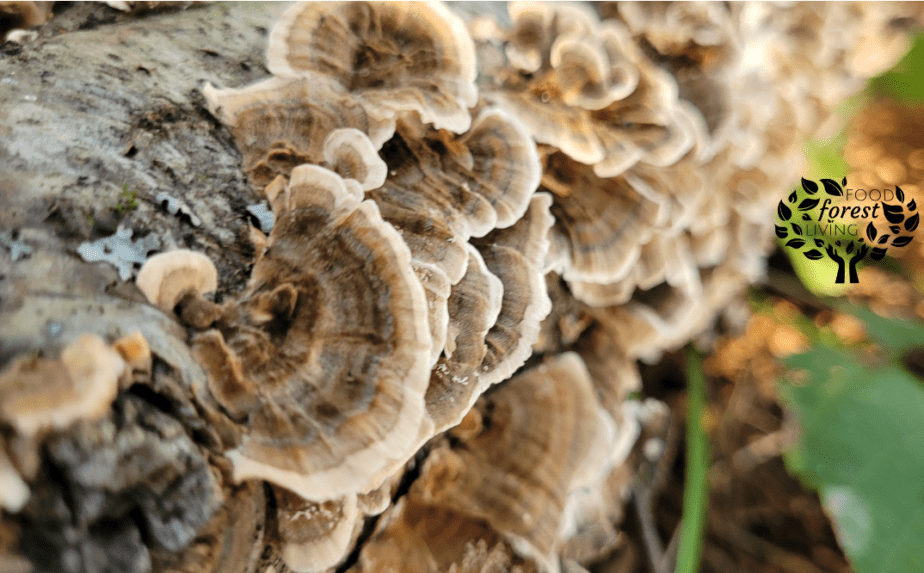


Since turkey tails are vigorous growers, you can have good success rates by inoculating several kinds of wood. They are generally happy with any deciduous tree in any form. The form can include logs, stumps, woodchips, and sawdust.
We prefer inoculating logs.
Why grow turkey tails if you can’t eat them like a typical mushroom? It’s true they are too tough to actually eat, but turkey tail tea is one of our favorite homemade warm drinks.
Its mild earthy flavor is accompanied by this smooth deep ‘body’ that is tough to describe, but so satisfying! The ‘body’ even makes coffee taste better, in my mouth’s opinion! I find black coffee particularly to be less “empty-acidic-feeling” with it added.
We brew one cup of turkey tail to 4-5 cups of water for 4-6 hours on an instant pot’s “keep warm” setting. If you don’t have access to freshly foraged turkey tails or are undecided about cultivating them, you can add this turkey tail powder to your morning brew for a month and a half—then decide!
Every time we make a batch, I also give turkey tail tea to my dog Sadie.
6. Chestnut mushrooms (on logs)
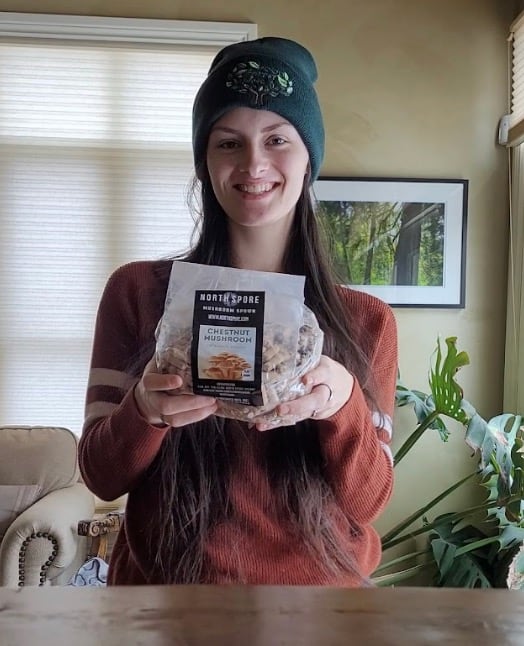
Chestnut is an intermediate mushroom to grow, according to North Spore. We recently inoculated logs with chestnut plugs.
Chestnut mushrooms are usually grown either indoors starting on grain spawn, or on logs outside starting with sawdust or plug spawn.
7. Lion’s mane (on logs or sawdust)
Lion’s Mane is one of my favorites. You can grow it on hardwood logs or sawdust. The top choice is maple, then beech, then elm, oak, and birch. Lion’s mane doesn’t tolerate competition well, so a fresh medium is a must.
Lion’s mane mushrooms are medium-easy to grow.
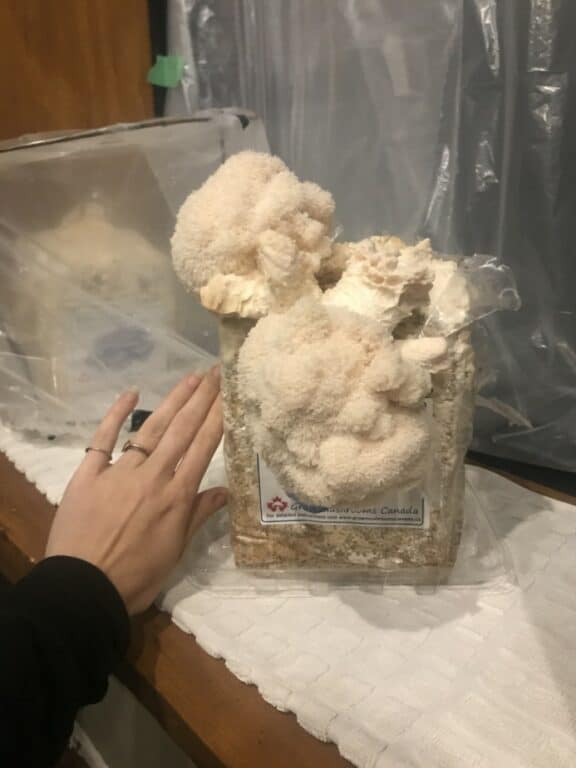
We grew our first lion’s mane in a growing kit! From a kit, you could top it up with sawdust to continue production. To turn it into logs, you can throw in some hardwood dowels, wait for them to colonize, and later put them into fresh logs. Then, you have lion’s mane logs!
Lion’s mane is one of my favorite tasty-textured mushrooms.
Try out this recipe: Lion’s Mane Mushroom Avocado Toast Recipe
Or learn more about lion’s mane cooking techniques and health benefits
8. Bear’s head tooth (on various log types)

Bears head tooth grows on deciduous hardwoods and has been seen less commonly on coniferous wood. They prefer maple, oak, beech, birch, and walnut. We found several on maples and oaks.
These are medium-easy mushrooms to grow.
Like all other mushroom logs, you’ll need plug spawn, a drill, a drill bit, a depth stop, and wax for inserting and sealing the plugs.
The distinction between bear’s head tooth mushroom and lion’s mane mushroom is the appearance between icicles and one of those shaggy shower carpets.
9. Shaggy mane (in a manure mushroom bed)
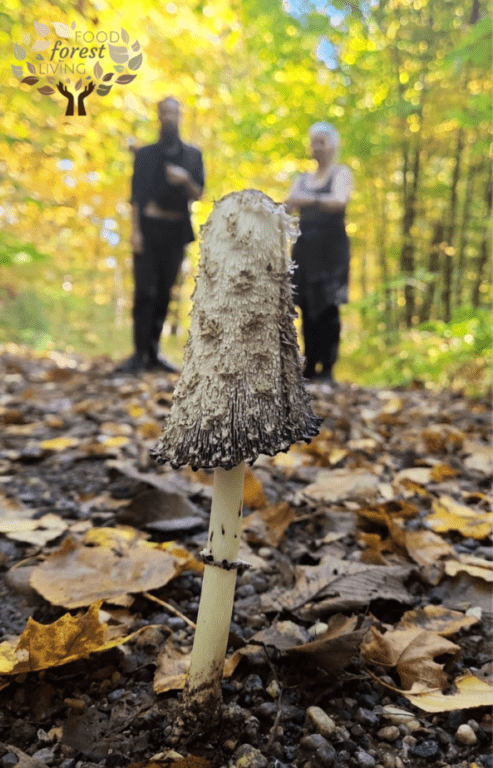
Shaggy mane mushrooms can easily be ground in beds. They don’t grow directly on wood.
They can grow within wood chips, but they are growing out of the rich humus provided by the decay of various materials.
To grow these; you’ll need a spawn source, straw, and composted horse or cow manure. With equal parts of straw and manure, layer your bed at least 8 inches with spawn sprinkled throughout.
Shaggy mane mushrooms are not for beginners. You’ll first need to master making your own grain spawn so they can be added to the bedding material.
10. Maitake (hen of the woods) on prepared logs
The tricky part about preparing your logs for either Maitake or chicken of the woods is the size. To steam, pressure cook, or boil sizeable logs requires sizeable equipment.
The video below will show you how to grow both maitake and chicken of the woods with short logs.
Related: What time of year do you inoculate mushroom logs?
Maitake mushrooms prefer to grow on oak wood. These are also the BEST but medium-hard to grow.
If sterilized straw is easier for you to get, make a maitake bed instead with sawdust spawn.
11. Chicken of the woods (on prepared oak logs)
Chicken of the woods can taste great if cooked a certain way. If you don’t cook using moisture, it can dry be dry out quite a bit, to almost chokeable. In general, it does resemble dry chicken. When cooked with moisture, its taste and texture are like juicy dry chicken. I love it . . .
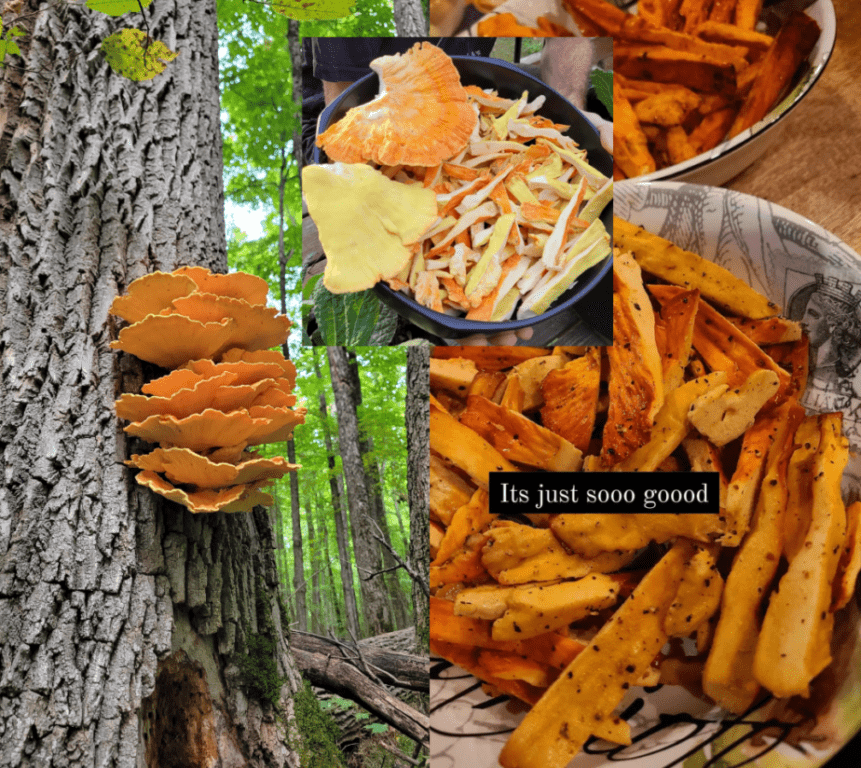
Chicken of the woods and maitake (hen of the woods) are best grown on hardwood logs with a bit of preparation. It is possible to grow them without the extra steps but will reduce your success rate.
They prefer to grow on dead or dying oak and beech trees. All other tree types aren’t recommended.
Okay, chicken of the woods mushrooms are very difficult to grow, but they make it on the list because they are the BEST.
For your convenience, here is where to find chicken of the woods plug spawn.
Recent Posts
There’s no shortage of full-sun ground covers for zone 4 climates! Each plant in this list can withstand the frigid temperatures and also enjoy the hot sun in summer. Full sun means that a plant...
There's no shortage of full sun ground covers, not even in zone 3! Zone 3 climates offer hot but short-lived summers and very cold winters. So each plant in this list can withstand the frigid...
